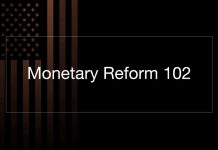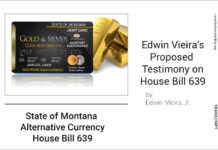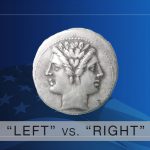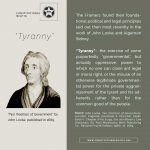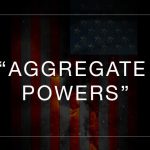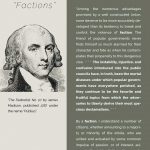Last Updated on September 11, 2021 by Constitutional Militia
Constitutional Authority of the States and the President to Intervene on Behalf of Sound Money
Committee for Monetary Research and Education
Monograph No. 39 (December 1983)
by Edwin Vieira, Jr.
Download the model legal-tender act for state legislatures here.
INTRODUCTION
The fundamental reason for the involvement of the United States in the present day crisis of international banking is the existence and operations of the domestic corporative-state banking-monopoly known as the Federal Reserve System – and in particular, the essentially unlimited politically uncontrollable license Congress has extended to that System to generate Federal Reserve Notes: the legal tender paper tokens, irredeemable in silver or gold coin or bullion, that today function as this country’s fiat currency. At the very center of the international banking-crisis are the leading private banks comprising the Federal Reserve System At the very center of the United States’ own chronic domestic monetary crisis is the Federal Reserve System. Therefore, not surprisingly, the United States finds itself swept up in the flood-tide of international monetary catastrophe or, perhaps more properly, jettisoned into the maelstrom by the very “money managers” who caused the crisis in the first place.
However, from the perspective of United States law (with which this monograph is primarily concerned), the crisis of international banking is irrelevant to the monetary problems besetting this country. To be sure, the Federal Reserve System and the irredeemable Federal Reserve Note are root causative agents of the present situation. Both the Federal Reserve System and the irredeemable Federal Reserve Note are unconstitutional – the one, because of its corporative-state structure, and the other, because of its irredeemability in silver or gold coin.(1) The United States government therefore, has no legal obligation and probably no legal authority, to mitigate the international banking-crisis through any action that would support in any way the viability of the Federal Reserve System or the value of the Federal Reserve Note. Quite the contrary: The United States government has the highest legal obligation and authority to disestablish the Federal Reserve System and to decry Federal Reserve Notes as soon as possible, even if these steps greatly exacerbate the crisis.
The international monetary system is a disaster primarily because the United States has long attempted to impose the Federal Reserve System’s debauched fiat currency as a world-wide standard of value. The global scope of the disaster, however, does not imply the necessity, let alone the practicality or even the possibility, of a global solution. Before planning a “new economic order” for other nations, the United States should first prove that it has the economic intelligence, political will and (above all) moral virtue and courage to put its own monetary and banking houses in order by- (i) reinstituting as its domestic medium of exchange constitutional commodity- money comprised of silver and gold coins; and (ii) reforming domestic banking operations by strictly regulating or (better yet) abolishing entirely, the fractional-reserve system.(2) If the United States can restore sound money to its own citizens before the collapse of the international banking establishment not only will it weather the economic and social storms that collapse inevitably will cause, but also its example will stimulate other nations to resurrect their own stricken economies on the basis of intelligent principles, rather than simply to reinstitute in a new guise the same fallacious ideas about money and banking that led to the present catastrophe.
The unanswered question though is: “How can the United States restore a domestic system of sound money?” The solution to this problem requires analysis of three issues: (i) why this country now has a system of unsound money; (ii) whither this system will lead if permitted to operate unchanged-and (iii) whether a legal means exists to transform it.
PART I
The United States government’s contemporary policy of monetary debasement is the expectable political-economic product of the normal operations of a totalitarian democracy.
One of the few historically validated axioms of political science is that an unlimited democracy cannot permanently exist as a form of government For, from the moment the voters discover they can enrich themselves from the public treasury, the majority inevitably votes for candidates promising the greatest governmental largesse and benefits, with the inexorable results of increasingly irresponsible fiscal policy, public bankruptcy, economic and social collapse, civil strife, and the replacement of democratic profligacy with the austerity and discipline of oligarchy or tyranny. Today, notwithstanding the federal structure of national and state governments the Constitution ordains, the sharply defined and limited powers of the national government it enumerates, and the fundamental individual freedoms it guarantees, from the perspective of monetary and fiscal policy the United States is a centralized totalitarian democracy. As the democratically elected representative of the people, Congress now claims the powers: (1) to tax any or all of the income of every person within its jurisdiction; (2) to spend these tax-receipts, and all other public monies, in whatever way it deems politically expedient but primarily on subsidies, “transfer payments”, and other forms of redistribution of wealth from those without influence to those who exercise it and (3) to emit fiat currency in order to underwrite expenditures above and beyond direct taxation through monetization of public debt by the Federal Reserve System’s corporative-state banking-monopoly.
The evolution – or, more properly, the declension – of the United States from a constitutional republic to a totalitarian democracy is primarily the fault of the institution popularly believed to be the guardian of the Constitution but historically exposed as its chief enemy in the monetary and fiscal fields: the Supreme Court. By its decisions in Knox v. Lee(3) and Julliard v. Greenman(4) until in the late 1800’s, erroneously upholding the power of Congress to emit bills of credit; its decisions in the Gold Clause Cases(5) in the 1930’s, erroneously sustaining congressional authority to “demonetize” gold, and its consistent refusal in recent years even to hear, let alone to decide, cases raising constitutional issues concerning money and banking;(6) the Court has simply eradicated for all practical purposes, any constitutional restraint on congressional manipulation of money.(7) Similarly, by its decision in United States v. Butler,(8) erroneously declaring that Congress has unlimited authority to spend public monies for whatever the legislators claim are “Public” purposes, and its decisions in Massachusetts v. Mellon(9) and Frothingham v. Mellon(10) erroneously denying both the States and private citizens any right to challenge the constitutionality of the national government’s expenditures in most instances; the Court has excised from the Constitution for all practical purposes, any limitation on congressional dissipation of the public treasury.(11) As a matter of law, these decisions constitute a license for Congress to exercise constitutionally unlimited – that is, totalitarian – power to “tax and tax, spend and spend inflate and inflate, and elect and elect.”
Fundamentally, popular statism (the ideology of totalitarian democracy) advocates perverting the political process from its rightful purpose of protecting the lives, liberty, and property of individual citizens to the “social-democratic” goal of attacking the lives, liberty and property of politically weak minorities in order forcibly to confiscate their wealth and transfer it to politically powerful majorities, or coalitions of minorities. Popular statism fallaciously assumes, however, that government is somehow independent of the laws of economics; that it can actually create new real wealth through the emission of irredeemable legal-tender fiat currency; that it can radically redistribute existing wealth by taxation and spending without consuming capital or otherwise lowering standards of living; and overall that it can pervasively intervene in economic and social affairs through monetary, fiscal and regulatory measures without imposing significant undesirable costs on society as a whole. Of course, exactly the opposite is true.
To be sure, taxpayers are not helpless against the ravages of redistributive statism. If taxpayers learn that they are subsidizing the huge system of governmental “transfer payments”, how much this system costs them, and how little real benefit it confers on them, then they can support tax-limitation referenda or constitutional amendments, elect legislators who actually work for tax-reductions, or even engage in massive tax-evasion and resistance.(12)
Modern popular statism, however, has developed a new apology for prodigal governmental spending that deceives the vast majority of taxpayers in this regard: Keynesianism. Redistrubutive interventionism – the system of “tax and tax spend and spend elect and elect” – is no political novelty in this country. But in the past the “orthodox” belief that governmental deficits were a symptom of financial irresponsibility in the conduct of public affairs tended to militate against the natural political-economic incentives for increased governmental spending. Keynes and his epigones provided a theoretical rationalization for governmental irresponsibility in the claim that a balanced budget reflects “old-fashioned” thinking and need no longer be a goal of fiscal policy. Thus, whereas in the “old order” increases in highly visible and generally unpopular taxation usually accompanied increases in public expenditure, the advent of Keynesian inflationism stripped away political restraints from the limitless growth of the public sector. Under Keynesianism, politicians can indulge in politically popular spending without recourse to politically unpopular taxes to finance it and with the explicit approval of the academic establishment.(13)
Keynes thus made redistributive statism politically convenient. The monetization of public debt to pay for governmental deficits with fiat currency and limitless central-bank credit-expansion operates as a tax on nominal assets, but a tax: (i) that requires no formal legislative procedure for enactment (ii) that those who ultimately pay it almost never perceive as a “tax”, and (iii) that the government’s propagandists can blame on such scapegoats as Arab sheiks, multinational corporations, the “gnomes of Zurich”, and so on.(14) Moreover, the Keynesian era brought a revolution not only in political economics, but also in constitutional law – for, with the earlier help of the Supreme Court in Knox, Juillard, and the Gold Clause Cases, Keynesian theory enabled Congress to establish a system of taxation without representation, and government without the informed consent of the governed, thereby effectively repealing the Constitution in perhaps its most important particulars.
PART II
Absent the restoration of a sound monetary system, the United States will soon degenerate into a totalitarian corporativistic state.
The nation’s political-economic system is out of control. Next to no one considers the supreme law of the land a restraint on the formulation or implementation of governmental policy in the monetary and fiscal fields. Congress exercises its purportedly unlimited powers in these fields heedless of the teachings of economic science. And the incentives inherent in totalitarian democracy foster ever-increasing instability in the country’s political economic, and social arrangements.
Assumedly, a fragile political consensus exists for a vague policy of “limiting the growth of governmental spending” but no significant agreement has yet emerged on the set of specific governmental expenditures to limit or on exactly how much to limit them. Moreover, those who concur in the need for public austerity generally eschew significant deflation of the existing supply of fiat currency and bank credit and never even suggest reintroduction of silver and gold coin limitations on or abolition of fractional-reserve banking, or any of the other requisites of a sound monetary system. In short the conventional wisdom advocates “stabilizing” America’s – and indeed the whole world’s economy at the very apex of the most prolonged and intense inflationary “boom” in history! And it proposes to achieve such “stabilization” through the selfsame mechanisms of ‘fine-tuning of the economy’ that caused the present disaster.
Furthermore, as economic chaos lingers or intensifies, political pressure to “do something” will certainly encourage, and likely serve as an excuse for (if not actually force), the national government to expand its intervention until in cooperation with the Federal Reserve System, it assumes totalitarian control over the economy as a whole. Increasingly weighty evidence indicates that the “new economic order” already in the planning-stage will be decidedly corporativistic in character.
Recently, the Full Employment Action Council and the National Policy Exchange, two influential left-wing groups with strong connections to organized labor and the Democratic Party, published a tract by Ray Marshall Marcus Alexis, Gar Alperovitz, and other luminaries entitled “An Economic Strategy for the 1980’s: The Failure of Reaganomics and the Full Employment Alternative.” Even conservatively viewed, this document is the rather obvious harbinger of an all out campaign by the union movement and its political and intellectual allies for the establishment of a full-blown, totalitarian corporative state in this country. “[A] comprehensive anti-inflation policy”, the tract proclaims, requires a mechanism for agreement among government labor, and industry at the highest levels on the price, wage and income growth rates that are consistent with steadily reducing the overall inflation levels. For such a consensus-based policy to work all the key players must take part directly, and all forms of income must be on the table – not just wages and prices, but rents, dividends and interest as well.
The essence of sound economic policy in the future will be to integrate the wide variety of public and private sector decisions that bear on the nation’s capacity to achieve full employment economic growth and stable prices A means must be created to establish and discuss realistic long-term goals review private sector responses to public sector stabilization policies resolve conflicting objectives and construct the proper mix of general and selective policies. To be effective, such discussions must involve all the major concerned parties-industry, labor, and government.
Since existing formal or informal institutions are not sufficient, a National Economic Policy Board (NEPB) should be created. The members of the board would include labor, business government and independent experts. The Federal Reserve Board also should play an active role.(15)
Not accidentally, these proposals for a “National Economic Policy Board” and “industry committees composed of the labor, business and government leadership involved in each particular sector” are exact parallels of the actual “National Recovery Administration” and the industrial “code authorities” established under the fascistic National Industrial Recovery Act(16) which the Supreme Court declared unconstitutional without dissenting voice in 1935.(17) The new – and ominous – twist is the explicitly “active role” for the Federal Reserve System”(18)
The decided tendency of contemporary political-economic events, then illustrates the prescience of the dictum generally attributed to Lenin that “the best way to destroy the capitalist system is to debauch the currency.”
PART III
Under present political-economic conditions only affirmative action by the States or by the President of the United States can restore a sound monetary system to America’s citizens.
Today’s domestic and international monetary crises are the expectable results of the advent of totalitarian democracy in this country, emphasizing the delusiveness of the Supreme Court’s notion that the only way individuals can protect their economic rights “in a complex society” is by participation in the electoral process.(19) Nearly one hundred years ago, wiser jurists realized that
The results of a turbulent restless temporary impulse on the part of the people or majorities … may be reflected in … legislation. In such cases the people need protection from their own hasty acts. – [C]onstitutions are designed to serve as a check thereon. If they do not do this they are but a delusion and a snare.(2O)
And almost two centuries ago, the Founding Fathers of this country provided a set of precisely defined tightly integrated constitutional restraints on the monetary powers of government that are anything but “a delusion and a snare.”
Indisputably, the Constitution established provisions for a national system of money. The standard of value in this system is the “dollar“, containing 371.25 grains of fine silver, as Congress memorialized in the Coinage Act of l792. (The Founders did not need explicitly to address the dollar as the national “Money-Unit” or to define the word in the Constitution – because the Continental Congress had already performed that task). The legally declared value of all non-subsidiary silver coins must relate proportionately to the weight of fine silver they contain in comparison to the dollar. The legally declared value of all non-subsidiary gold coins must relate proportionately to the weight of fine gold they contain in comparison to the dollar, at the prevailing free-market exchange-ratio between silver and gold And neither the national nor the state governments may emit any form or species of paper currency.(21)
Taken together, these constitutional requirements define a monetary system that relies on market principles as much as any governmentally-based system could. First the Constitution adopted the type of money the world market historically favored: commodity money. Second the Constitution adopted as money the very commodities the quality of which the international market historically recognized as preeminent silver and gold. Third the Constitution adopted the specific unit of money the American market found most convenient during the 1700’s: the “dollar” of 371.25 grains fine silver. Finally, through the system of “free coinage”, the Constitution left the ultimate supply of money to the market too. In short, to the extent compatible with the existence of any government at all, the Constitution “degovernmentalized” money in its most important particulars.
Since ratification of the Constitution however, the country has suffered a radical re-politicization of money. The unfortunate series of events in the declension of the national monetary system from one informed by market principles to one manipulated by political expediency has transpired despite, not perforce, the Constitution. For example, in the teeth of Article I Section 8, Clauses 2 and 5 of the Constitution Congress began the emission of legal tender paper currency in 1862. Next notwithstanding the irrelevance of debates over the “gold standard” and “free silver” in the context of the Constitution’s command in Article I Section 8, Clause 5 that Congress must “regulate the Value” of all “Money” (be it composed of gold or silver) according to the national unit of account the silver dollar, Congress agonized itself and agitated the country over these spurious issues from 1870 to 1900. Then in defiance of the Constitution’s delegation to the national legislatures alone in Article t Section 8, Clause 5 of the power “To coin Money (and) regulate the Value thereof,” in 1913 Congress created the corporative state banking-cartel disingenuously named the Federal Reserve System. Finally, in derogation of every constitutional monetary power and disability, Congress declared Federal Reserve Notes legal tender for all debt (1933), outlawed the redemption of those notes (or any governmental obligations) in gold coin (1933), seized the American people’s supply of gold (1933), “demonetized” gold (1934), and at last outlawed the redemption of Federal Reserve Notes and paper currencies of the national government in silver, too (1968) – thus substituting the fiat paper currency of a private banking-consortium and the government’s own base-metallic token coinage, for the constitutional regime of gold and silver.
This history proves that office-holders concerned more with pleasing their political constituents than with performing their legal duties can ignore and flaunt the Constitution because they have done so. It does not prove, however, that the constitutional powers and disabilities regarding money have been “set aside”, have been “amended” by practice, or have “evolved” to comport with the contemporary economic theories of the “welfare state.” The Constitution means and commands today precisely what it meant and commanded in the late 1700’s; for no amount of usurpation and tyranny can dispense with or change its provisions – by proclamation or by practice – in the slightest degree. This fundamental rule of constitutional law, moreover, is not of simply academic interest Admittedly, the fashion these days is to ignore constitutional restraints on governments so-called “economic” powers as mere hortatory rhetoric unsuited to the modern era of radical interventionism As Justice Peter Daniel well said:
“It is indeed a sad symptom of the downward progress of political morals when any appeal to the Constitution shall fail… to suggest the necessity for solemn reflection. Still more fearful is the prevalence of the disposition either in or out of office to meet the honest or scrupulous devotion to its commands by that newborn wisdom which measures the Constitution only by its own superior and infallible standard of policy and convenience. By the disciples of this new morality it seems to be thought that the mandates or axiom of the Constitution when found obstructing the way to power, and when they cannot be overstepped by truth or logic, may be conveniently turned and shunned under the denomination of abstractions… ; and the loyal supporters of those mandates may be born down under the reproach of a narrow prejudice or fanaticism … wholly beyond the sagacity and requirements of the age.”(22)
Contemporary political fashions and “the downward progress of political morals” to the contrary notwithstanding the Constitution remains, by its own terms, “the supreme Law of the Land.” (23) The important issue is not whether the Constitution is relevant to monetary policy, but whether it is enforceable against the Federal Reserve System and its partisans.
Contrary to the popular misuse of legal terminology, the federal government of the United States consists of five parts: Congress,(24) the President(25) the judiciary,(26) the States,(27) and the people.(28) Each of these branches of government has the legal right and power, and the duty, to support and defend the Constitution – Congress, the President the courts, and officials of the States, because the Constitution requires them to take an “Oath or Affirmation” to that effect;(29) and the people, because they are responsible for “ordain[ing] and establish[ing]” the Constitution in the first place.(3O)
The Founding Fathers believed that every man invested with power is likely to abuse it.(3l) For that reason they sought protection against tyranny and usurpation not only in a democratic “dependence on the people,”(32) but also in an elaborate interlocking system of constitutional checks and balances,(33) and in the doctrine of judicial review.(34) As experience has demonstrated however, the Founders did not sufficiently appreciate that judges with life-tenure(35) are not less covetous of power than ephemeral legislators, and that every judicial decision extending the authority of the legislative and executive branches of government also enhances the authority and importance of the judges who interpret and apply the laws.
Consequently, the existence of a set of dangerously ambiguous precedents on monetary law weighs heavily against any action by the Supreme Court in favor of sound money Correctly interpreted neither Knox v. Lee(36) nor Juilliard v. Greenman(37) nor any of the Gold Clause Cases (38) provides the least rational support for the claim that Congress may constitutionally emit legal-tender fiat currency irredeemable in silver or gold coin or delegate such a power to the corporative-state Federal Reserve System.(39) Rather, the decisions support the contrary positions.(40) They contain much loose language about the seemingly unlimited power of Congress “to establish a national currency, either in coin or in paper, and to make that currency lawful money for all purposes”(41) – upon which language the partisans of fiat currency have understandably (albeit disingenuously) seized in support of their position.
Now, only two alternatives exist: The Supreme Court must interpret these precedents either to support the constitutionality of fiat currency, or to deny its lawfulness. To do the second however, the Court must take upon itself the responsibility of suddenly invalidating the monetary rules upon the authority of which the market has structured an infinity of complex economic relationships and interactions. Doubtlessly, a Court with the moral courage of its convictions – and a decent concern for its oath of office – could enunciate a rule mitigating or obviating any truly unjust economic dislocations that rigorous enforcement of the Constitution might occasion.(42) But a Court lacking such courage would likely view its intervention as “too late”, and therefore politically and economically unwise, no matter how legally proper.(43) Such of course, was the view of the late Justice Jackson who described as
utterly beyond judicial reach … the money, taxing, and spending power which is the power of inflation. The improvident use of these powers can destroy the conditions for the existence of liberty, because [they] can set up great currents of strife within the population which might carry constitutional forms and limitations before them.
Yet wrote Jackson “[n]o protection against these catastrophic courses can be expected from the judiciary. The people must guard against these dangers at the polls.”(44) Under the political- economic incentives of totalitarian democracy, though the people cannot “guard against these dangers at the polls”, because it is precisely the operation of special interest-group electoral politics that causes “these catastrophic courses” in the first place. Only strict enforcement of the Constitution can protect the country from the “improvident use” of alleged powers that Congress does not have. But paradoxically, the greater the economic and social harm a violation of the Constitution’s monetary provisions has already caused, the greater the willingness of such as Jackson – and, in all likelihood the present Court – to disregard or pervert the Constitution in order to sanction that violation. Or, the more totalitarian democracy employs fiat currency to destroy the fabric of American society, the more the Supreme Court will encourage and aid it to do so!
For a glaring example, the Supreme Court refused to hear an appeal in the case Solyom v. Maryland National Capital Park & Planning Commission on the ground that the appeal did not present a “substantial” federal question.(45) Solyom however, presented numerous issues of monetary law, including:
(1) whether a State may pay a debt it owes to a private citizen with irredeemable Federal Reserve Notes, notwithstanding the command of Article 1, Section 10, Clause I of the Constitution that” (n)o State shall… make any Thing but gold and silver Coin a Tender in Payment of Debts;”
(2) whether the purported payment of irredeemable Federal Reserve Notes for land seized through exercise of the power of eminent domain constitutes “just compensation” under the Due Process and Just Compensation Clauses of the Fifth and Fourteenth Amendments to the Constitution;
(3) whether Congress has the authority to emit irredeemable paper currency of any kind, and
(4) whether Congress may license a cartel of private banks to emit irredeemable paper currency with legal tender character.(46)
On their face, these issues are anything but “insubstantial.” A Constitutional claim is “insubstantial” only if “its unsoundness so clearly results from the previous decisions of (the Supreme Court) as to foreclose the subject and leave no room for the interference that the questio(n) … can be the subject of controversy.”(47) The Supreme Court has never ruled on any of these issues one way or the other!
Solyom thus demonstrates the multiple bankruptcy of today’s Supreme Court (i) its intellectual bankruptcy, if it could not deduce from previous decisions (or, indeed from the absence of previous decisions) that the issues raised in Solyom were substantial (ii) its political bankruptcy, if it could not realize that the present system of “spend and spend inflate and inflate, elect and elect” is out of control and will inexorably drive the country to disaster absent the intervention of legal controls on totalitarian democracy, (iii) its moral bankruptcy, if it could not fulfill its duty honestly to decide constitutional issues presented to it and (iv) its personal bankruptcy, if it could not muster a single justice of sufficient integrity and grit to acknowledge how callously and with what cowardice the Court as a whole was surreptitiously disposing of the most important Constitutional question of modem times.
Unlike Congress and the Supreme Court, several States have recently taken direct action against the continuation of the Federal Reserve System’s regime of fiat currency. For example, the State of Alabama memorialized Congress “immediately (to) enact such legislation as is necessary to repeal the Federal Reserve Act.”(48) And the State of Washington enacted a resolution declaring its intent to “fil(e) in the original jurisdiction of the Supreme Court… (a)n action challenging the Constitutionality of the delegation of power to create money to the Federal Reserve System.”(49) Unfortunately, as insightful and laudable as these initiatives may be, they are misdirected. Their success depends on cooperation from either Congress or the Supreme Court – the two branches of the national government least likely to contribute anything to the restoration of monetary stability in the United States.
The States, however, do enjoy a Constitutional power of self help in this regard. Article I, Section 10, Clause 1 of the Constitution provides that” (n)o State shall… make any Thing but gold and silver Coin a Tender in Payment of Debts”, clearly implying that the States retain the power to make such Coin “a Tender.” Moreover, the Tenth Amendment to the Constitution provides that “(t)he powers not delegated to the United States by the Constitution nor prohibited by it to the States, are reserved to the States respectively, or to the people”, adding further support to the States’ retained authority to ” make” “specie “a Tender in Payment of Debts.” The necessary statute would not be difficult to draft and perhaps to pass in States such as Alabama and Washington.(50) Once enacted in one or more States, such a law would immediately have important economic, political and legal consequences; (i) it would effectively demonetize the Federal Reserve Note, substituting therefor constitutional commodity money of silver and gold (ii) It would intensify the popular debate on monetary policy throughout the nation illustrating a practical legislative approach to the problem of restoring sound money, in direct contradiction of the arguments of spokesmen for the establishment that “no realistic alternative” to fiat currency exists. (iii) It would provoke Congress to challenge the States’ reserved legal tender power, through legislation or litigation – in either event bringing the Constitutional issues into the open instead of continuing the pretense that they do not exist or have already been settled with legal and intellectual rigor in favor of irredeemable paper money.
On the other hand the political effectiveness of such a state legal tender law would depend in large measure on how many and which particular States acted in unison. The fewer, more localized, or less important the States, the easier for the mass-media to dismiss the movement as narrowly “ideological” or “sectional” in nature. In addition the fewer, smaller, or less powerful the States involved the easier for Congress or the inferior national courts to suppress the movement early on through punitive legislation or judicial decrees, without meaningful review by the Supreme Court under some perverse interpretation of the Supremacy Clause of the Constitution.(51) Coordinating mutual action and support among numerous state legislatures, though could be decidedly difficult.
The President of the United States, on the other hand is a single individual not a majority of Congress of the Supreme Court or of one of the State legislatures – and for that reason can take decisive, because unilateral action. Moreover, from the perspective of practical politics, the election of
a President appears decidedly easier than the election of a two-thirds majority of Congress (or certainly of most of the state legislatures);(52) and at least possible within a reasonable time-span unlike the appointment of five new justices to the Supreme Court.(53) From the perspective of political legitimacy, also, presidential action appears preferable to judicial or even perhaps legislative initiatives. For unlike the national judiciary, the President is a popularly elected official – and “at some times, on some subjects,… the President elected by all the people is rather more representative of them all than are the members of (Congress) whose constituencies are local and not countrywide,” (54) and whose allegiances are more often to powerful special interest groups than to the nation as a whole. In addition from the perspective of constitutional law, the President occupies a branch of the national government co-equal to Congress and the Supreme Court and therefore his actions are not subject in any sense to the possible infirmity of state legislation under the Supremacy Clause.
That the President has the power to act on behalf of sound money there can be no doubt. Article II Section 3 of the Constitution provides that the President “shall take care that the Laws be faithfully executed.” And Article VI Clause 2 explicitly identifies the Constitution as part of “the supreme Law of the Land.” Therefore, on its face, the Constitution itself commands the President to “take Care that the [Constitution] be faithfully executed.” And the Supreme Court has sustained this interpretation of the President’s authority.(55) Moreover, this duty to execute the laws, coupled with the President’s oath of office under Article II, Section 1, Clause 7, empowers him to determine for himself all relevant legal issues involving the statutes or constitutional provisions he enforces. On the strength of the oath of Justices of the Supreme Court “to support this Constitution.”(56) Chief Justice John Marshall held in Marbury v. Madison,(57) that the Court has the authority and the responsibility to decide the constitutionality of congressional enactments involved in cases before it.(58) The President takes an oath however, not merely”to support” the Constitution but rather and further to “preserve, protect and defend it.”(59) If the justices’ simple oath enables–and indeed requires–them to decide constitutional questions arising in the performance of their duties, surely the President’s more compelling commitment extends to him the same right and duty of office.
The President’s power to “take Care that the laws be faithfully executed” is broad, encompassing every situation within what the Constitution terms the “executive Power,”(60) and every circumstance appropriate for what John Locke (the fountainhead of American constitutionalism) called “Prerogative”, “the Power of doing public good without a Rule.”(61) Precisely how broad the power may be, no one can say – for the Founding Fathers “intended [the Constitution] to endure for ages to come, and consequently, to be adapted to the various crises of human affairs”, and therefore endowed that document with “means … adequate to its ends.”(62) Certainly they believed with Alexander Hamilton that
[e]nergy in the Executive is a leading character in the definition of good government. It is essential . . . to the protection of property against those irregular and highhanded combinations which sometimes interrupt the ordinary course of justice; to the security of liberty against the enterprises and assaults of ambition of faction and of anarchy.(63)
Because few serious students of today’s monetary situation would characterize it as anything less than a “crisis” that poses the gravest threats to the property and liberty of all the country’s citizens, the President’s power self-evidently extends to execution of all constitutional provisions touching on inflation.
Three situations are possible with respect to the President’s power to “take Care that the Laws be faithfully executed”: (i) Either the President acts pursuant to an express or implied congressional authorization in which case he may exercise all the power he possesses in his own right together with all the power that Congress may delegate to him.(64) Or, (ii) the President acts in the absence of either a congressional grant or denial of authority, in which case he may exercise only his own independent powers.(65) Or, (iii) the President acts in contravention of the expressed or implied will of Congress, in which case he may exercise his own independent powers only to the extent that that exercise does not conflict with the constitutional exercise by Congress of its independent powers. (66) In each of these situations however, the President has the inherent authority to decide for himself independently of the opinions of Congress or the Supreme Court whether what Congress has authorized forbidden or refused or neglected to do is itself constitutional that is, whether Congress’ action or inaction is a “Law” of the United States at all itself to be “executed” or to be set aside pursuant to the Constitution.
The most important congressional actions with respect to money involve: (i) the practical demonetization of the (silver) dollar, the constitutional standard of value, and of gold coin properly regulated in value as against the dollar (ii) the creation of the corporative-state Federal Reserve System and the delegation to it of a license to emit Federal Reserve Notes that purportedly constitute obligations of the United States; (iii) the extension of legal-tender character to Federal Reserve Notes, supposedly for all debts, public and private; and (iv) the effective repudiation of Federal Reserve Notes, by refusing to redeem them at any exchange-ratio, for silver or gold coin or bullion Each of these actions is unlawful Once the President has so determined to his own satisfaction he can immediately on his own initiative implement a program “faithfully [to] execute” the Constitution so as to render these congressional enactments mere nullifies as far as the executive department is concerned. Simultaneously, he can present Congress with an uncompromising legislative proposal for the restoration of sound money – and then veto every bill that fails to embody the necessary provisions, and refuse to enforce every unconstitutional monetary statute that Congress passes over his veto, until either Congress enacts the laws necessary for a constitutional monetary system, or the people remove the President from office at the next quadrennial election.(67)
The President it should be emphasized has no power to enforce his interpretation of the Constitution directly on Congress or the Supreme Court a disability befitting one of the three “coordinate” branches of the national government.(68) On the other hand deriving his powers directly from the Constitution and not from any congressional grant or judicial decision, the President is also independent of Congress and the Supreme Court and legally beyond their control.(69) Certainly Congress has no authority whatsoever to define the boundaries of presidential power.(70) Neither does the Supreme Court.
In the modern era of the “imperial judiciary”, the popular misconception holds that the courts are arbiters of the law in general and of the Constitution in particular, as against the other branches of the national government. The Founding Fathers “did not make the judiciary the overseer of our government.”(71) They gave the national courts, including the Supreme Court no license to “invade the province of the other [departments of government]”, or to “control direct or restrain the[ir] action[s].”(72) Because the”[Supreme] Court may fall into error as may other branches of the Government”, neither Congress nor the President should feel any embarrassment let alone fear any legal disability, in acting contrary to judicial pronouncement they consider incorrect.(73) Certainly the President has no duty whatsoever to concern himself with “faithfully execut[ing]” judicial decisions – for these decisions are not “Laws”, strictly speaking, but rather merely evidence of what the courts think the “Laws” are (and often quite unsatisfactory evidence, at that).(74) Neither need he “faithfully execut[e]” the “laws” (including the Constitution) only after and as the Supreme Court has interpreted them.(75)
Ultimately, the President is answerable – not to Congress, the Supreme Court or the States – but only to the fifth branch of the federal government: the, people. If the people agree with his actions on behalf of sound money, they will re-elect him to office, retire those Representatives and Senators who oppose him, and support impeachment and conviction of all judges of the national courts who incautiously dare to contradict the President’s interpretation of the monetary provisions of the Constitution.(76) If the people do not agree with his actions, they will remove him from office, one way or another. In either case, the responsibility for events will be theirs, as it always must be in a system of representative government.
CONCLUSION
The present-day crisis of international banking should alert this country to how near the collapse of its own monetary system has come. Time is short. The leader capable of using what little time remains to the best advantage of sound money has yet to appear on the national political stage. Perhaps he never will. But then we all shall have only ourselves to blame for what happens to us.





























